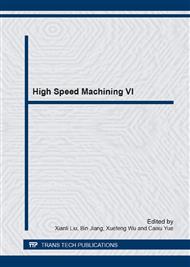[1]
M. Mohammadpour, et al. Simulation Modelling Practice and TheoryVol. 18 (2010), p.378–389.
Google Scholar
[2]
P. J. Arrazola, T. Ozel, D. Umbrello. CIRP Annals Manufacturing TechnologyVol. 62(2) (2013), pp.695-718.
Google Scholar
[3]
Jawahir. IS, Brinksmeier, E. M'Saoubi R, et al. CIRP Annals-Manufacturing Technology Vol. 60(2) (2011) 603-626.
Google Scholar
[4]
Saurabh Agrawal, Suhas S. Joshi. Journal of Manufacturing Processes Vol. 15 (2013) p.167–179.
Google Scholar
[5]
S.Y. Liang, J-C. Su. Annals of the CIRP. Vol. 56(1) (2007), pp.65-67.
Google Scholar
[6]
Johnson GR, Cook WH. Procedings of the 7th Int. Symposium on Ballistics, The Hague, The Netherlands (1983), p.541–547.
Google Scholar
[7]
Mohammad Sima, et al. International Journal of Machine Tools & Manufacture Vol. 50 (2010), p.943–960.
Google Scholar
[8]
Calamaz M, Coupard D, Girot F. International Journal of Machine Tools & Manufacture Vol48 (2008), p.275–288.
Google Scholar
[9]
Calamaz. M, Coupard D, Girot F. Cutting Science and Technology Vol. 14(2) (2010), p.244–257.
Google Scholar
[10]
Sima. M, O¨zel T. International Journal of Machine Tools & Manu-facture Vol. 50(2010), p.943–960.
Google Scholar
[11]
O¨zel. T. International Journal of Machine Tools & Manufacture Vol. 46(5) (2006), p.518–530.
Google Scholar
[12]
Zorev NN. ASME International Research in Production Engineering, ASME, New York (1963), p.42–49.
Google Scholar
[13]
Puls. H, Klocke. F, Lung D. Production Engineering (2012) p.1–6.
Google Scholar
[14]
H. Ben Abdelali, et al. Wear Vol. 286–287 (2012) p.108–115.
Google Scholar
[15]
Li J L, Jing L L, Chen M. Journal of Materials Processing Technology Vol. 209(9) (2009), 4515-4520.
Google Scholar
[16]
UMBRELLO D, AMBROGIO G, FLICE L.A. Materials and design Vol. 29(4)(2008), pp.873-883.
Google Scholar
[17]
Chen. L, El-Wardany. TI, Harris WC. CIRP Annals Manufacturing Technology Vol. 53(1) (2004), pp.95-98.
Google Scholar
[18]
Umbrello D, M'Saoubi R, Outeiro JC. International Journal of Machine Tools & Manufacture Vol. 47(3-4)(2007), pp.462-470.
Google Scholar
[19]
Umbrello. D, Outeiro J C, M Saoubi R, et al. CIRP Annals-Manufacturing Technology Vol. 59(1) (2010), P. 113-116.
Google Scholar
[20]
Ratchev SM, Afazov SM, AA. CIRP Journal of Manufacturing Science Technology Vol. 4(1) (2011), pp.80-89.
Google Scholar
[21]
Y.B. Guo, S. Anurag, I.S. Jawahir. CIRP Annals - Manufacturing Technology Vol. 58 (2009), p.81–84.
Google Scholar


